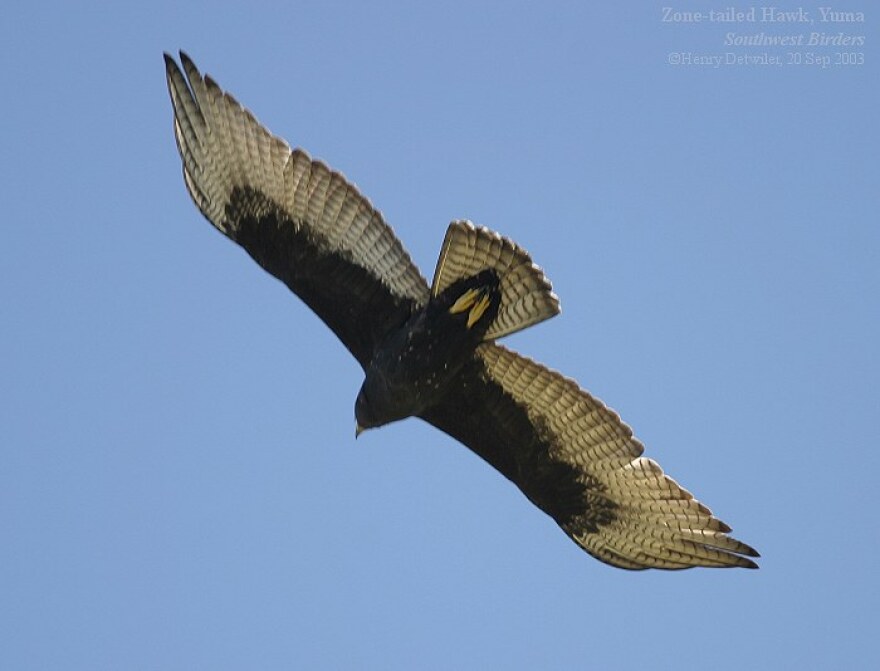From the Northern reaches of the Llano Estacado in Eastern New Mexico to the Big Bend Borderlands of Texas, this is Nature Notes.
Zone tailed hawks are rare, but if you see a flock of Turkey Vultures, you might also find this hawk hiding in plain sight.
From Marfa Public Radio, in cooperation with the Sibley Nature Center in Midland, Texas, this is Nature Notes. Hello, I’m Dallas Baxter.
Many birdwatchers are passionate about finding new species of birds to add to their life list. Some birders especially seek species of birds native to the United States. The Big Bend region of the Chihuahuan Desert and the Balcones Escarpment along the southern edge of the Edwards Plateau hosts one such target species -- the zone-tailed hawk. The species can also be found in southern New Mexico and southern Arizona.
Everyone is familiar with Turkey Vultures, those huge black birds that circle high in the sky, searching for road kill, predator kills and animals dead from natural causes. Zone-tailed hawks often fly hidden among the buzzards, for they are also dark and can soar with wings raised dihedrally in a "v." Unlike vultures, though, their heads are feathered. Since the vultures eat only dead animals, ground squirrels, birds and other targets of the hawks feel safe in the turkey vultures’ presence and don’t flee when a vulture soars over. Like the animals, most folks don’t take the time to look at every flock of vultures to see if a zone-tailed, with its subtle gray banding on the tail, is circling high with them, so few people are familiar with the species. And few people live in the remote areas where they nest.
With such a limited range, birdwatchers come from all over the United States to attempt to add the zone-tailed hawk to their life list, and their numbers substantially contribute to the region's economy.
Zone-tailed hawks build large bulky nests in larger trees along water courses and on the tops of smaller trees in tight box canyons. If a person is paying attention to sounds while traipsing around the zone-tailed habitat, their attention may be drawn to the zone tailed’s high pitched scream, much like that of red-tailed hawks whose sound we hear in almost every Western movie. The zone-tailed's call has a falsetto screech in the middle of the scream. If a hiker is near their nest when it’s full of young, the screams will be insistent. They’ve been known to slash a human's scalp if a person approaches within 100 feet.
Zone-tailed hawks have a spectacular courtship flight. The pair engages in a strenuous play chase, full of dives, rolls, close passes and full 360 degree loops.
Only one set of two or three eggs is laid each year. During incubation, the female rarely leaves the nest. The male brings her food, and he continues his labors during the first couple of weeks after the hatchlings’ birth. In drought times with limited food, the strongest chick may kill its siblings, reducing the annual reproduction rate to just one young that reaches adulthood. After leaving the nest, the young will sometimes wander from the normal range – there’s even a verified record of one in Nova Scotia. During the winter, Zone-tailed hawks leave the United States for Central and South America, returning in late March.
Zone-tailed hawks have a varied diet, but observers have recorded a seeming preference for ground squirrels, snakes, collared and spiny lizards and small birds such as lark sparrows, blue grosbeaks and other seed eating birds. After heavy rains have brought toads to the surface and to temporary pools, a zone-tailed hawk will take advantage of the brief period of time when thousands of the amphibians are present to vary its diet.
When traveling in the mesa and canyon country of the region, take the time to look over a circling flock of turkey vultures. You might just see this amazing and uncommon hawk, hiding in plain sight.
Nature Notes is sponsored by the Dixon Water Foundation and is produced by KRTS Marfa Public Radio in cooperation with the Sibley Nature Center in Midland, Texas. This episode was written by Burr Williams of the Sibley Nature Center. Visit sibleynaturecenter.org and join Williams' Facebook page where photos are posted daily. I’m Dallas Baxter. Thanks for listening.


